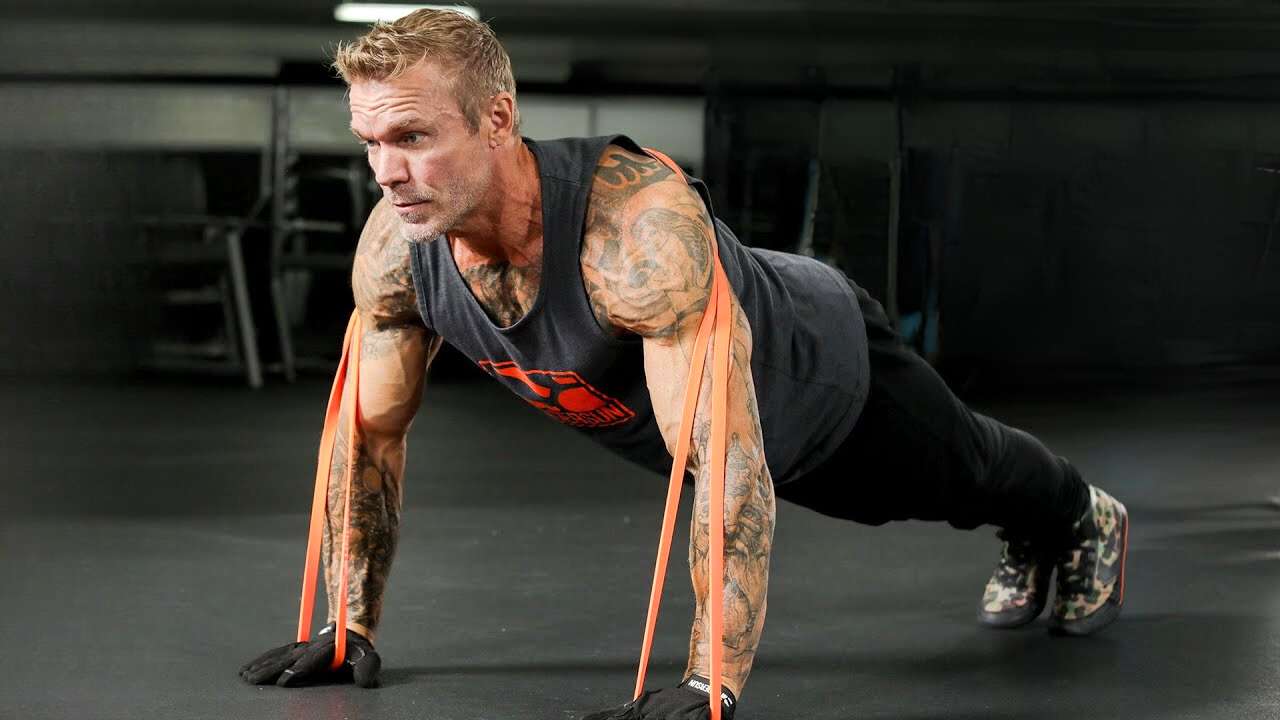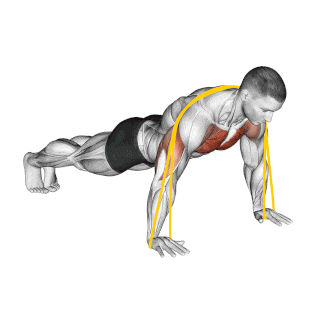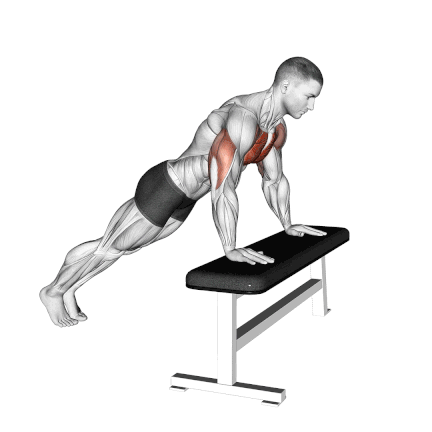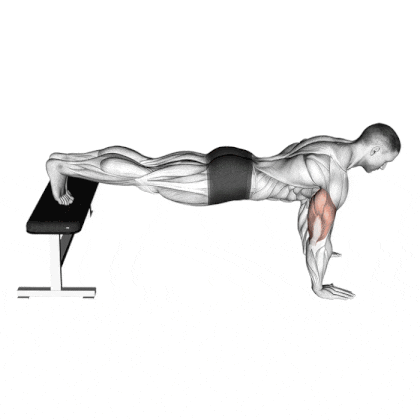Resistance band push-ups are a variation of the standard push-up exercise that adds extra challenge and resistance by using the band.
As the name suggests, they are performed using a resistance band or loop placed across the upper back while in the push-up position.
Research has shown that resistance band push-ups can be as effective as traditional bench press exercises for building strength and muscle mass in upper body.
Although it primarily targets the chest muscles, it also engages several other muscles, including the shoulders, triceps, and core.
You can also modify it to make them easier or more challenging as per your convenience.
For example, you can use a thicker resistance band to make the exercise harder, or you can put your feet on a bench to make it easier (Decline Push-up).
Want to take your gains to the next level? Discover your daily calorie needs with our free TDEE calculator

Band Push Up Muscles Worked
The Resistance Band Push-Up is a compound exercise that engages multiple muscle groups simultaneously.
- Primary Muscles: Pectoralis major (chest) and triceps brachii
- Secondary Muscles: Anterior deltoids (front shoulders), serratus anterior (upper ribs)
- Stabilizing Muscles: Core (rectus abdominis, obliques), glutes, and lower back (erector spinae)

How To Do Resistance Band Push-Up
- Start with a flat, looped resistance band. The band’s thickness and elasticity will determine the resistance.
- For beginners, it is best to start with lighter resistance bands and move to heavier ones as you get stronger.
- Get into a plank position with your hands slightly wider than shoulder-width apart.
- Ensure your body forms a straight line from your head to your heels.
- Place the band onto your upper back, ensuring that it is straight and not twisted.
- Secure each end of the band under the palms of your hands on the ground.
- Inhale and start to lower your body towards the ground. Keep your elbows at about a 45-degree angle to your body.
- Once your chest is close to the ground, pause for a moment.
- Exhale and press through your hands to push yourself back up to the starting plank position.
- Keep your core tight to keep your hips from sagging or piking up.
- Start with 2–3 sets of 10–12 reps with 30-60 secs rest between sets.
- If you’re new to this exercise, start with fewer reps and increase them as you improve and strengthen.
- Do 2–3 times per week along with other upper body exercises.
Tips and Form
- Band Check Protocol: 90% of people skip inspecting their bands for micro-tears before each session. Band failure typically starts 72 hours before visible damage appears.
- Place hands exactly 1.5x shoulder width apart. This creates what biomechanists call optimal “force vector alignment” for chest recruitment.
- Lock in that 45-degree elbow angle. This isn’t just random – studies show this specific angle optimizes the stress-to-safety ratio for your shoulders.
- Inhale during the eccentric (lowering) phase, and exhale during the concentric (pushing) phase. This isn’t just bro-science—according to recent research, it enhances intra-abdominal pressure by up to 23%.
- Engage your core muscles to keep your body straight and stable as you perform the push-up. This will engage your TVA (Transverse Abdominis), your body’s natural weight belt.
- Beginner Modification: Start with knee push-ups, but the key most people miss is keeping the same hip-to-shoulder angle as a full push-up. This maintains the movement pattern for easier progression.
- Almost touch the chest to ground each rep. Why? This maintains a consistent range of motion, which is crucial for tracking progress.
- Everyone’s strength curve is different. Focus on perfect form with manageable resistance before chasing numbers. Remember that form degradation starts 2–3 reps before visible form breakdown.

To Stay Motivated: 150+ Gym Workout Motivational Quotes To Stay Fit
Best Resistance Band Push-Ups Variations
These resistance band variations aren’t just random exercises—they’re scientifically proven chest-builders that deliver the best muscle activation along with standard push-ups.
1. Incline Band Push Up
An incline push-up is a variation of the standard push-up where your hands are positioned on an elevated surface, such as a bench, step, or wall. It mainly focuses on the lower chest.
The incline angle reduces anterior shoulder stress by about 15-20% compared to flat band push-ups, based on EMG studies. This means you can train harder with less joint wear and tear.
Adjusting the incline’s height or changing the band’s resistance level can easily modify incline band push-ups.

2. Band Decline Push Up
The Band Decline push-up is a more advanced variation of the standard push-up. In this exercise, the feet are elevated on a platform or surface (like a bench), and a resistance band increases the challenge.
Although this is called the Decline push-up, it focuses more on the upper pecs.
Despite looking more intense, decline band push-ups can actually be shoulder-friendly. Why? The decline angle reduces the horizontal abduction at your shoulder joint, potentially decreasing impingement risk.

3. Close Grip Band Push Up
It is one of the best bodyweight exercises that focuses more on the inner chest and triceps because it uses a close-hand position.
EMG studies show close grip push-ups activate the triceps up to 1.7x more than standard push-ups. Add bands, and you’ve got what I call “progressive triceps overload” – exactly what you need for arm development.
Common Form Killers:
- Hands too close (kills your gains and stresses elbows)
- Elbows flaring out (bye-bye triceps emphasis)

Try this band push-up; your chest, shoulders, and triceps will thank you.
References
- Behm D.G., Anderson K., Curnew R.S. (2002) Muscle force and activation under stable and unstable conditions. Journal of Strength and Conditioning Research 16(3): 416-422.
- Calatayud J, Borreani S, Colado JC, Martin F, Tella V, Andersen LL. Bench press and push-up at comparable levels of muscle activity results in similar strength gains. J Strength Cond Res. 2015 Jan;29(1):246-53.
- Calatayud J., Borreani S., Colado J.C., Martin F., Rogers M.E. (2014) Muscle activity levels in upper-body push exercises with different loads and stability conditions. Physician and Sportsmedicine 42, 106-119.

Manish is a NASM-certified fitness and nutrition coach with over 10 years of experience in weight lifting and fat loss fitness coaching. He specializes in gym-based training and has a lot of knowledge about exercise, lifting technique, biomechanics, and more.
Through “Fit Life Regime,” he generously shares the insights he’s gained over a decade in the field. His goal is to equip others with the knowledge to start their own fitness journey.
